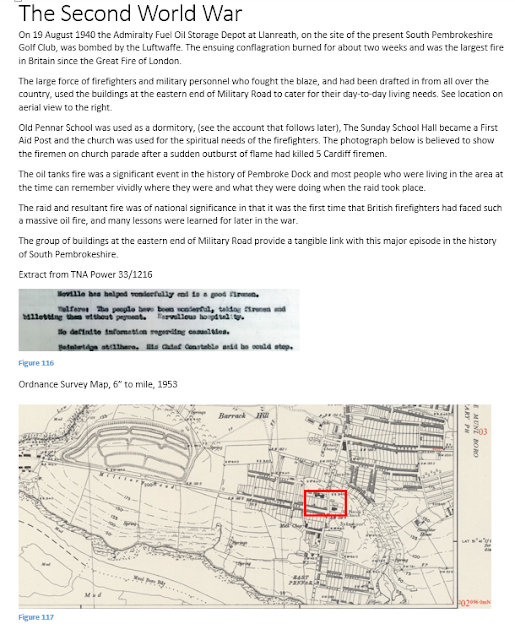As part of the the request for listing a building you are also asked to give the historical background to the building.
For Old Pennar School, there is information in files in The National Archives and at Pembrokeshire Archives, as well as some old newspaper reports and documents in private hands.

Files in The National Archives include ED 21/67383, an extract of which is reproduced, courtesy of TNA. This is a school inspector's report from 1938, and is interesting as it mentions how some of the classrooms were arranged.
In the Pembrokeshire Archives are files that tell us what the school was like initially.
Details of
specification and cost. This shows that the school initially comprised three
classrooms.
Mixed Girls School Room:
50 ft x 20 ft x 26 ft high
20ft x 15 ft x 20 ft
high
Infants classroom
50ft x 20ft x 26ft high
The school
was remodelled in 1894 to provide an extra infants classroom. Cost was £270.
30ft x 18ft
x 16ft high (Wall Plate 12 ft)
In 1897 the school accommodated 123 Girls and 193
Infants.
The school
was again enlarged in 1901, bringing it up to its present form.
Mixed Girls School Room:
51 ft x 20 ft x 20 ft high
46ft x 20 ft x 20 ft
high
20ft x 20 ft x 20 ft
high
Infants classroom
33 ft x 24 ft x 20 ft
22 ft x 24 ft x 20 ft
30 ft x 19 ft x 18 ft
The extract below from my submission to CADW for listing, explains (in part) the relationship between the bombing of the Oil Tanks (In August 1940) and Old Pennar School:
I shall give you a few more extracts in my next post.


My comment to CADW, if I were able to communicate with that body directly, would be that there are two educational buildings of the most significant historical importance in Pembroke Dock and these are Albion Square and Pennar school buildings. Each has a unique part in the history of the town. Whilst both these buildings are no longer used for the purpose built, that does not mean that they should be ignored - on the contrary, now is the time to ensure that they are not allowed to either fall into disrepair or be acquired by avaricious developers. We cannot allow these signally important structures to fall foul of the apathy which seems to exist in Wales generally and Pembrokeshire particularly. Once buildings such as these are lost they can never be replaced. They were designed for local use, built by local craftsmen using good local materials they have outlived other more modern buildings. This issue is of great import to those still resident in the town but also to others like myself who now live if divers parts of the world but still care that the heritage of the town we grew up in is not put in jeopardy because of inaction on the part of the very organisations who should be ensuring that that is not the case. We all now lament the destruction of the Argyle/Bush Street building that was once the County Grammar School for that too was steeped in history but has been lost forever because of the apathetic attitude of those who could have saved it.
ReplyDelete